Diabetes is the scourge of the Black community and there are pretty scary stats that lend credence to this statement. African Americans are almost twice as likely to be diagnosed with diabetes as non-Hispanic whites. In addition, they are more likely to suffer complications from diabetes, such as end-stage renal disease and lower extremity amputations. Lastly, African Americans are twice as likely as non-Hispanic Whites to die from diabetes. So a diabetes diagnosis should never be taken lightly!
Yet many with a diagnosis of diabetes are still in the dark about their blood sugar level numbers that show how well they are managing their condition. Once the levels are under control, there is less chance of experiencing serious health consequences like kidney disease and loss of vision.
How do you measure blood sugar?
There are now two ways to measure blood sugar level. You can do a self-check at home or an A1C blood test that is ordered by a physician.
The A1C test reveals your average blood sugar level over the past two to three months. The test is performed by drawing your blood and then having it analyzed in a lab.
The at-home blood sugar level test can be done by using a blood glucose meter. The device uses a drop of your blood from a finger then reveals your result.
What are the target blood sugar levels for diabetics?
Diabetics have various target blood sugar levels they should reach for at various points throughout their day. Doctors advise that the targets should be:
- Before a meal: 80 to 130
- Two hours after the start of a meal: Below 180
Be sure to have a thorough discussion with your physician before you leave their office to make sure you FULLY understand what your particular blood level targets should be!
How many times a day should you check your blood sugar level?
Depending on the type of diabetes you’ve been diagnosed with will determine the type of medicine you’ll need to take. Folks who are on insulin might need to check their blood level more often. Ideal times for checking blood levels are typically when you first wake up, pre-breakfast, two hours after eating and before you hit the sack at night. You should, however, always check with your physician to determine the best times to check your individual blood sugar level.
What to do if your blood sugar level is low
If your blood sugar level falls below 70, then you are experiencing hypoglycemia that has to be addressed without wasting a moment! If you’re a diabetic, then low blood sugar can strike at any given moment.
If you experience the following symptoms then your blood sugar is probably too low:
- Shakiness
- Sweating
- Extreme hunger
If your blood sugar is low and you need an emergency fix to raise it up again, the National Institutes of Health recommends that you do one of the following things immediately:
- Chew 4 glucose tablets
- Drink 4 ounces of fruit juice
- Drink 4 ounces of regular soda, not diet
- Chew 4 pieces of hard candy (not sugar-free)
After following one of these suggestions, wait 15 minutes, then recheck your blood sugar level. Repeat the process until your level has increased to over 70. After your level has gone up, be sure to eat a snack if your next meal is an hour or more away. If you are having too many hypoglycemic episodes, talk to your doctor about reviewing your treatment plan especially if you drive.
What about A1C?
For diabetics, it is best to get your A1C level to under 7, and it should typically be tested twice a year. You may require additional testing if your diabetes treatment plan is changed by your physician.
The Bottom Line…
The main thing to do as a diabetic is to be vigilant and diligent about staying on top of your blood sugar level. Keep close ties with your physician and let him/her know if your numbers are erratic. Be willing to work as a team with your medical provider to keep your blood sugar goals where they should be.












[…] to Mary Ida, a nurse, and Luther, Sr., a singer and upholsterer. After Luther, Sr. passed away from diabetes complications, the Vandross family moved to the Bronx; Luther was 8-years-old at the […]